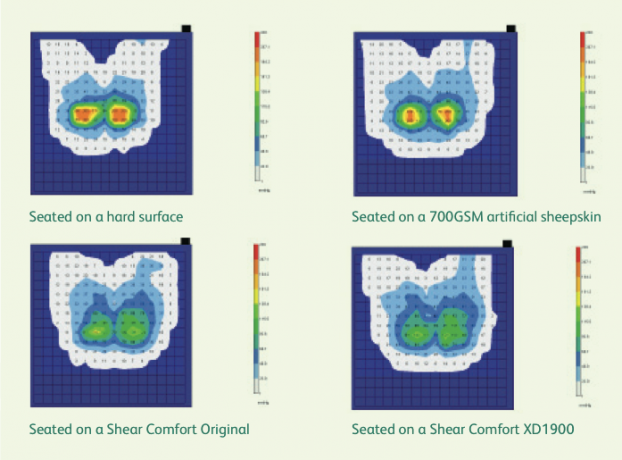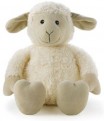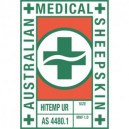Categories
Tags
Archive
2013
2014
2015
2016
2017
2018
2019
2020
The Benefits of Wool
August 11, 2016 at 9:09 AM
The following information has been derived from our suppliers website and relates to the Shear Comfort products manufactured by Healthcare Innovations Australia. Click here to view or purchase Shear Comfort products from our website.
Properties of Wool
Apart from keeping the body comfortable and warm, medical sheepskin possesses many unique properties that you may not be aware of.
Regulates Temperature
Wool helps the body regulate temperature by both insulating from the cold and dissipating heat. This is thanks to efficient airflow between the fibres enhanced by the natural crimping of un-spun wool. In cold conditions, warm air is distributed through the sheepskin, keeping the whole body equally warm. Sheepskin is a wonderful material to sleep on in hot weather too. The University of Sydney demonstrated this in their sleep research, which found that participants sleeping on wool in hot conditions (29°C) slept for significantly longer, had faster sleep onset and woke up less frequently during the night than participants sleeping on a mattress covered only by a sheet (Woolmark, 2011).
Wicks Moisture
Wool has the natural ability to wick moisture, and is known as a hydrophilic material for its ability to absorb moisture without actually feeling wet. Wool can carry almost one-third of its own weight in water before feeling wet to the touch, making it a popular fabric for traditional-style reusable diapers. Wet skin is very uncomfortable and over time can cause maceration and weakening of the skin, so this ability to wick moisture is a great benefit for both comfort and skin protection.
Reduces Shear and Friction
The outermost layer of protein on a fibre of wool makes it very smooth – making it easy for the fibres to move against each another and accommodate movement. This means that your skin moves across the surface with less resistance, keeping the shear and friction forces to a minimum. These forces can be a contributing factor towards a feeling of discomfort when seated or lying down.
Redistributes Pressure
Improved pressure redistribution is a proven quality of medical sheepskins. Every wool fibre acts like a tiny spring, absorbing pressure without flattening out and becoming solid. In pressure mapping images you can see the difference that a Shear Comfort Cushion-It makes in reducing peak pressure points compared to resting on a non-cushioned surface.

What is Shear Comfort?
Shear Comfort products use specially selected wool from a specific cross-breed of sheep to give it the optimum properties for pressure care and microclimate control.
You may have heard of Merino Wool, this is very commonly used in clothing as it has the finest fibre size, making it very soft. However, this also means it doesn’t perform quite so well as a pressure redistribution tool as the fibres compress too easily. So by crossbreeding a Merino sheep with an English Ram with coarser wool we can produce a wool that’s beautifully soft to touch, yet offers brilliant pressure redistribution at the same time.
Most of our products are made of our unique XD1900 material, manufactured out of medical grade sheep's wool which has been woven onto a different backing in order to achieve a higher fibre density. Thanks to the treatment process our wool goes through all Shear Comfort™ products can be washed up to and over 80°C, plus our XD1900 material can be washed using normal household detergent as it doesn’t have the natural leather backing.
All our products are made to exceed the Australian Medical Sheepskin Standard which guarantees their exceedingly high quality and therapeutic properties.
Australian Medical Sheepskin
All Shear Comfort products meet and surpass the Australian Medical Sheep Skin Standard AS4480.1 This standard stipulates that the wool needs to be of a high enough quality to perform as a medical device for pressure distribution purposes by meeting the following standards:
- Be well trimmed and pre-washed
- Have wool pile of uniform length and density, well-defined staple and crimp, straight to light curl in appearance that is free from pilling and vegetable matter.
- Possess a Wool fibre diameter of 26-34 µm (microns) and be 25- 30 mm long
- Stay flat when laid down- at all times, the product should be able lie flat on a horizontal surface with minimum curling around the edges.
- HiTemp Medical Sheepskins must have a minimum shrink temperature of 110°C
and the size should not decrease more than 5 cm after 50 wash cycles. - Be colourfast
Our products also carry the UR mark, which stands for Urine Resistant. Many natural sheepskins deteriorate when they come into contact with urine, but Shear Comfort does not.
Our Commitment to Wool Quality
We source the finest quality wool for superior pressure redistribution and comfort
Authenticity
Firstly, real wool comes from real sheep. Synthetic 'wool' products will not contain the same properties as sheep’s wool and are merely a cheap imitation. Synthetic fibres compress far more easily than natural wool, and do not spring back as fully, compromising the pressure-distribution quality of any synthetic 'sheepskin'. Because of this compression, airflow to the skin is reduced and the temperature-controlling and insulating properties of real wool are lost.
Synthetic fibres such as polyester are hydrophobic, and do not possess the moisture-absorbing capabilities of wool. Synthetic sheepskins were brought to the market because they were cheap, and could be washed at high temperatures. Shear Comfort Natural carries the Australian hi-temp UR stamp, which guarantees the product can be washed at 80°C without shrinking, keeping the wool hygienically clean. Synthetic sheepskins may look nice, but are most certainly a waste of money for any other use – only wool can do what wool can do.
Fibre Size
This is measured and expressed in microns, a measurement of the average fibre diameter. There are different applications for wools with different micron measurements for example a micron average of 11-30 is ideal for clothing where the softness and smoothness are important, a micron of 30+ is ideal for a rug or coat as it is particularly hard wearing. The fibre size is determined by the breed of sheep, for instance merino wool has a low micron measurement and is widely used in clothing. We use a wool from a Merino-English ram cross breed with a micron of 30 as our research has found this gives our wool an optimal balance of pressure redistribution and softness.
Pile Length
This is the length of the individual fibres and effects the pressure distribution properties of a sheepskin. The longer the fibres, the thicker the sheepskin. All our products have a pile length of 30mm, except a few items of footwear where slenderness takes priority over pile length. This is the higher-end of the pile length permitted by the Australian Medical Sheepskin Standard, making the sheepskin thick enough to distribute pressure but not so long that the fibres to get tangled amongst each other.
Fibre Density
Fibre density is very important in relation to the sheepskin’s ability to redistribute pressure, the more fibres you can pack into an area the better the pressure redistribution is going to be. The best that a high end medical grade natural sheepskin can achieve is 1200gsm, whereas we have honed a manufacturing technique to be able to pack in 1900gsm – this became our XD1900 material. Be careful though, as many cheaper products in the marketplace use skins with a density more like 800gsm. The Shear Comfort Pressure Map shows the difference this makes.
Wool and Flame Resistance
To learn about Wool and Flame Resistance, click here.
References: The Woolmark Company, 2011, [online] Available at http://www.merino.com/Content/en-GB/Media/Sleep_Research.pdf (Accessed 21/03/13)









